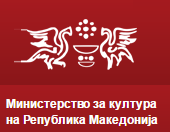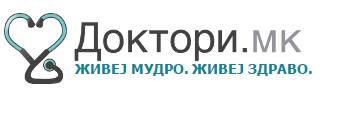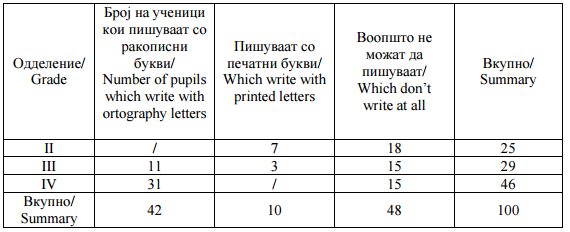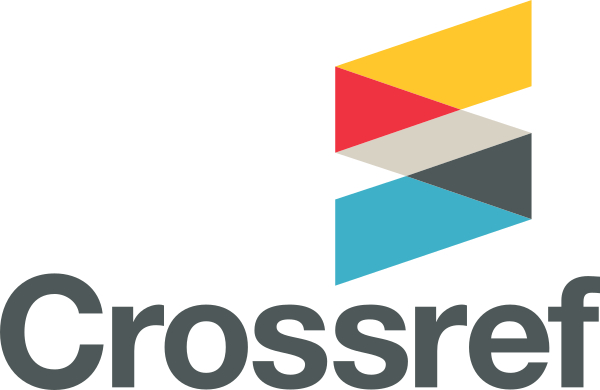JSER Policies
JSER Online
JSER Data
Frequency: quarterly
ISSN: 1409-6099 (Print)
ISSN: 1857-663X (Online)
Authors Info
- Read: 55923
|
ПРОЦЕНА НА ПРАВОПИСНОТО НИВО НА РАКОПИСОТ КАЈ ЛЕСНО МЕНТАЛНО РЕТАРДИРАНИТЕ УЧЕНИЦИ
Анета Т. ХРИСТОВА,1 |
|
APPRAISAL OF THE ORTOGRAPHY LEVEL OF THE HANDWRITING IN EASY MENTAL RETARDED CHILDREN
Aneta T. HRISTOVA,1
Elementary school Gorgi Sugarev – Bitola1 |
|
Примено: 17. 08. 2009 |
|
Received: 17. 08. 2009 |
|
|
|
|
| Вовед |
|
Introduction |
|
|
|
|
|
Под писмо се подразбира систем на знакови, со кои се бележат гласовите во одреден јазик. Овој систем се нарекува графија. Гласовниот систем на јазикот го сочинуваат говорни гласови, а графичкиот систем на јазикот го сочинуваат букви. Не само што гласовниот и графичкиот систем на различни јазици помалку или повеќе се разликуваат помеѓу себе, туку ни еден ни друг систем во ниеден јазик не се совпаѓаат потполно, што е разбирливо, затоа што гласовниот систем е посложен од графичкиот систем. Овие односи се регулираат со посебни правила, норми. Збирот на тие правила се нарекува ортографија (1). |
|
Under the term letter we understand a system of signs, with whom the voices are noted in a certain language. This system is called graphical. The voice system of the language is consisted of speech voices, and the graphic system of the language is made of letters. Not just that the voice and the graphic system in different languages more or less are different from one another, but neither the one or the other are entirely compatible, which is understandable, because the voice system is far more complex than the graphic one. These relations are regulated with special rules, standards. The sum of these rules is called orthography (1). |
|
|
|
|
|
Метод |
|
Method |
|
|
|
|
|
Примерокот опфаќа 100 испитаници, лесно ментално ретардирани ученици од основношколска возраст (II-IV одделение), од двата пола, без оглед на возраста, чиј степен на интелигенција према наодите од комисијата за распоредување на лица со посебни потреби е на ниво на лесна ментална ретардација. Според наодите на комисијата за распоредување на лица со посебни потреби, лесно ментално ретардираните деца се распределени според нивните карактеристики, од долна граница на лесна ментална ретардација, до горна граница на лесна ментална ретардација, без наведување на коефициентот на интелигенција (IQ) коjшто не е направен. |
|
The sample contains 100 examinees, with mild mental retardation pupils from elementary school (II – IV grade), from both sexes, regardless the age, and the degree of intelligence which according to the findings of the Commission for disposition of persons with special needs it is on level of mild mental retardation. According to the findings of the Commission for disposition of persons with special needs, children with mild mental retardation are classified according their characteristics, from the lower border of mild mental retardation, up to highest border of mild mental retardation, without stating the coefficient of IQ which is not done. |
|
|
|
|
|
Резултати |
|
Results |
|
|
|
|
|
За подобра проценка на правописното ниво на ракописот кај лесно ментално ретардираните ученици направено е следното:
- направена е споредба на правописното ниво на ракописот во однос на успехот по Mакедонски јазик. |
|
For better evaluation of the orthography level of the handwriting in pupils with mild mental retardation the following was done:
- A comparison was made of the orthography level of the handwriting according to the success in Macedonian language. |
|
|
|
|
|
Табела 1. Начин на пишување по диктат во зависност од одделението |
|
Table 1. Way of writing of a dictation of the grade |
|
|
|
Табела 1а. Правописно ниво на ракописот во зависност од одделението |
|
Таblе 1а. Ortography level of the handwriting depending of the grade |
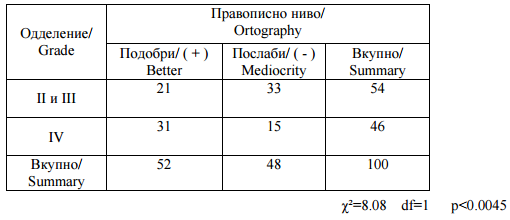 |
|
Правописното ниво на ракописот е оценето врз основа на зададената скала во Општата дефектолошка дијагностика (4). Рубриката - под ниво - опфаќа (додавање на букви, слогови, спојување на зборови, делови на зборови, скратување на зборови, заменување на букви, слогови). |
|
The orthography level of the handwriting was estimated on a base of a given scale from the General special education diagnostics (4). The column – under level- comprises (additional letters, syllables, connecting words, parts of words, shortening words, replacing letters). |

|
Слика 1: Анализа на правописното ниво на ракописот |
|
Figure 1. Analysis of the otrography level of the handwriting |
|
|
|
|
|
Табела 2. Правописно ниво на ракописот во однос на возраста и полот |
|
Таblе 2. Otrography level of handwriting according to the age and the gender |
 |
|
Табела 2б. Правописно ниво на ракописот во однос на полот |
|
Таblе 2b. Ortography level of handwriting according to the gender |
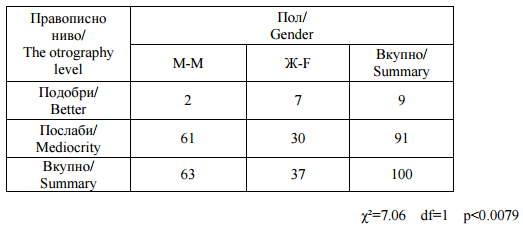 |
|
Табела 2в. Правописно ниво на ракописот во однос на возраста |
|
Таblе 2c. Ortography level of handwriting according to the age |
 |
|
Нивото на усвоеност во однос на полот и возраста е прикажано во заедничка табела заради подобра прегледност. Дихотомизацијата на возрасни групи: првата од 8-10 години и другата, од 11-13 години е извршена заради проверка со χ² тест (табела 2 и 2в). |
|
The level of comprehension in relation to the sex and age is represented in a joint board for better review. The dichotomization of the age groups: the first from 8-10 years and the other from 11-13 years is made in a confirmation with the HI square test (table 2 and 2c). |
|
|
|
|
|
Табела 3. Правописно ниво на ракописот во однос на успехот по Македонски јазик |
|
Таble 3. Ortography level of the handwriting according to the success in the Macedonian language |
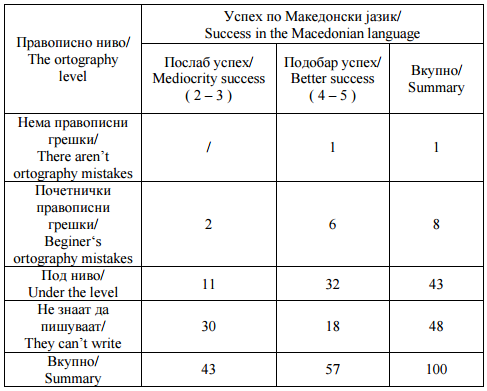
|
Табела 3а. Правописно ниво на ракописот во однос на успехот по Македонски јазик |
|
Табле 3а. Ortography level of the handwriting according to the success in the Macedonian language |
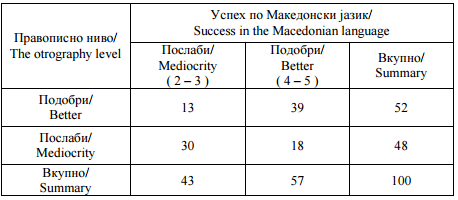 |
|
Дека оценката не е секогаш одраз на знаењето покажуваат резултатите на одделни случаи, добиени при споредување на правописното ниво на ракописот со успехот по Mакедонски јазик. Кај 91% од случаите правописот е под нивото, или поточно 48% од испитаниците од сите возрасти во одделенските групи не знаеја да пишуваат. Одовде и нереалниот подобар успех по македонски јазик кај 18 ученици кои воопшто не знаат да пишуваат (табела 3). Оценката навистина треба да биде стимул за подобра работа, но не во толкава мера затоа што би предизвикала спротивен ефект. |
|
That the evaluation is not always a reflection of the knowledge are showing the results of separate cases, received while the comparison of the orthography level of the handwriting with the success in Macedonian language. At 91% of the cases the orthography is under the level, or more exactly 48% from the examinees of all ages in the class groups did not know how to write. From this point comes the unrealistic better success in Macedonian language at 18 pupils which did not know how to write at all (table 3). The evaluation needs to be stimulation for a better job, but not in such measure because it will cause a side effect. |
||
|
|
|
|
||
|
Дискусија |
|
Discussion |
||
|
|
|
|
||
|
Резултатите од истражувањето покажаа ниско правописно ниво на ракописот кај лесно ментално ратардираните ученици. Овие резултати беа донекаде очекувани, со оглед на тоа што во групата испитаници беа опфатени деца кои на предучилишна возраст немале соодветен третман и не биле опфатени со задолжителното деветгодишно образование, кое во посебните паралелки стартуваше нешто подоцна отколку во редовната настава. |
|
The results of the research have shown a low orthography level of the handwriting in children with mild mental retardation. This results were somehow expected, taking into consideration that in the group of the examinees were included children which in the pre elementary age did not have the proper treatment and they were not included in the compulsory nine year education, which in the special classes started little later than in the regular teaching. |
||
|
|
|
|
||
|
Заклучоци |
|
Conclusions |
||
|
|
|
|
||
|
Врз основа на резултатите на истражувањето неизбежни се следниве заклучоци:
|
|
Based on the results of the research the following conclusions can be made:
|
||
|
|
|
|
||
|
Citation:Hristova TA, Filipova S. Appraisal of the Orthography Level of the Handwriting in Easy Mental Retarded Children. J Spec Educ Rehab 2009; 10(3-4):110-121. |
||||
|
|
||||
|
Литература / References |
|
|
||
|
|
|
||
Share Us
Journal metrics
-
 SNIP 0.059
SNIP 0.059 -
 IPP 0.07
IPP 0.07 -
 SJR 0.13
SJR 0.13 -
 h5-index 7
h5-index 7 -
 Google-based impact factor: 0.68
Google-based impact factor: 0.68
10 Most Read Articles
- PARENTAL ACCEPTANCE / REJECTION AND EMOTIONAL INTELLIGENCE AMONG ADOLESCENTS WITH AND WITHOUT DELINQUENT BEHAVIOR
- RELATIONSHIP BETWEEN LIFE BUILDING SKILLS AND SOCIAL ADJUSTMENT OF STUDENTS WITH HEARING IMPAIRMENT: IMPLICATIONS FOR COUNSELING
- EXPERIENCES FROM THE EDUCATIONAL SYSTEM – NARRATIVES OF PARENTS WITH CHILDREN WITH DISABILITIES IN CROATIA
- INOVATIONS IN THERAPY OF AUTISM
- AUTISM AND TUBEROUS SCLEROSIS
- THE DURATION AND PHASES OF QUALITATIVE RESEARCH
- REHABILITATION OF PERSONS WITH CEREBRAL PALSY
- DISORDERED ATTENTION AS NEUROPSYCHOLOGICAL COGNITIVE DISFUNCTION
- HYPERACTIVE CHILD`S DISTURBED ATTENTION AS THE MOST COMMON CAUSE FOR LIGHT FORMS OF MENTAL DEFICIENCY
- DIAGNOSTIC AND TREATMENT OPTIONS IN AUTISTIC SPECTRUM DISORDERS – AN OVERVIEW

